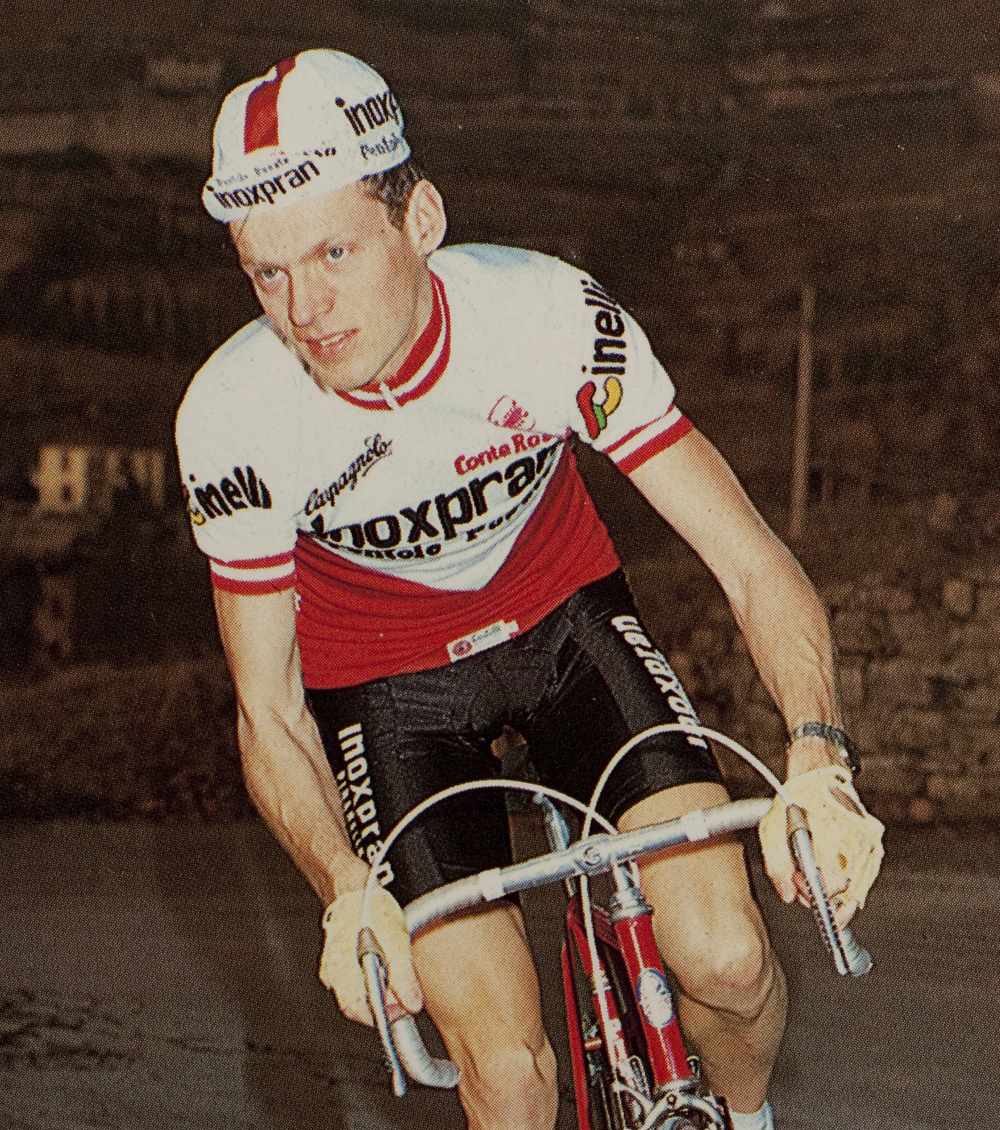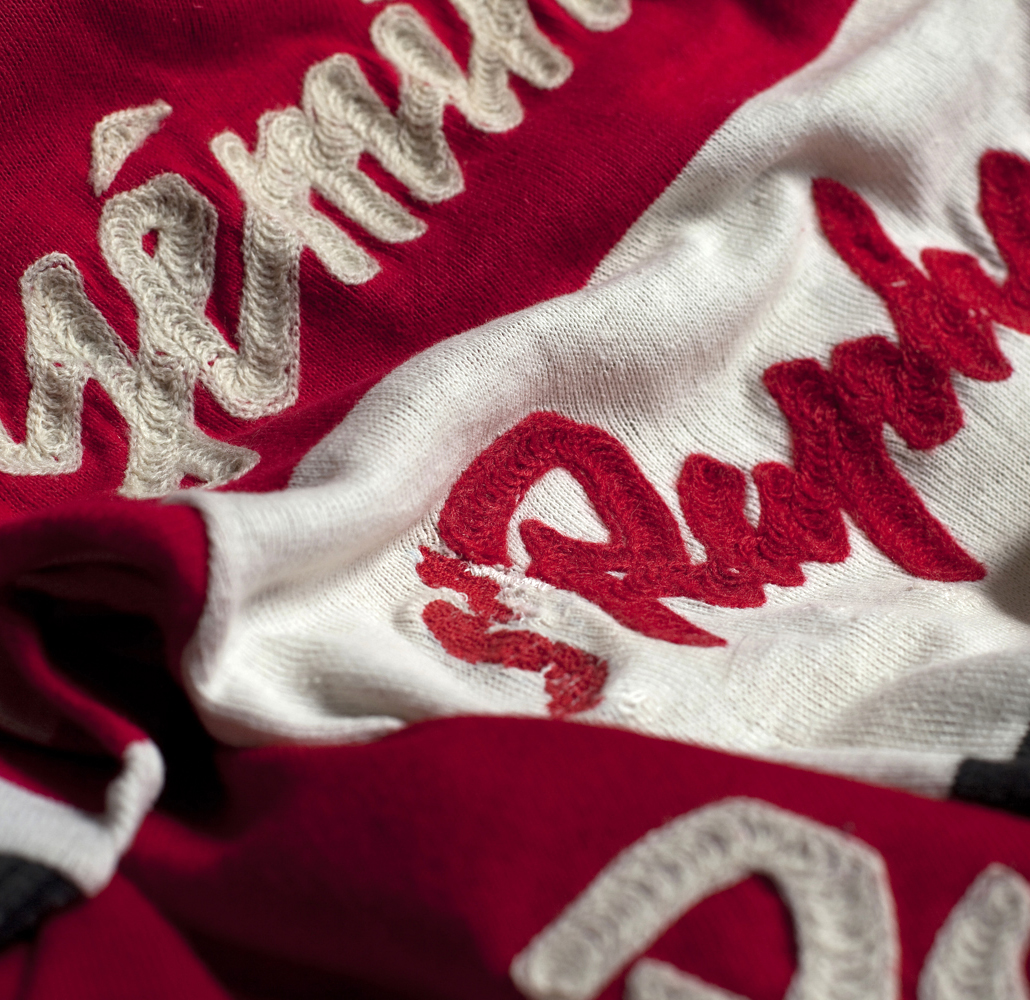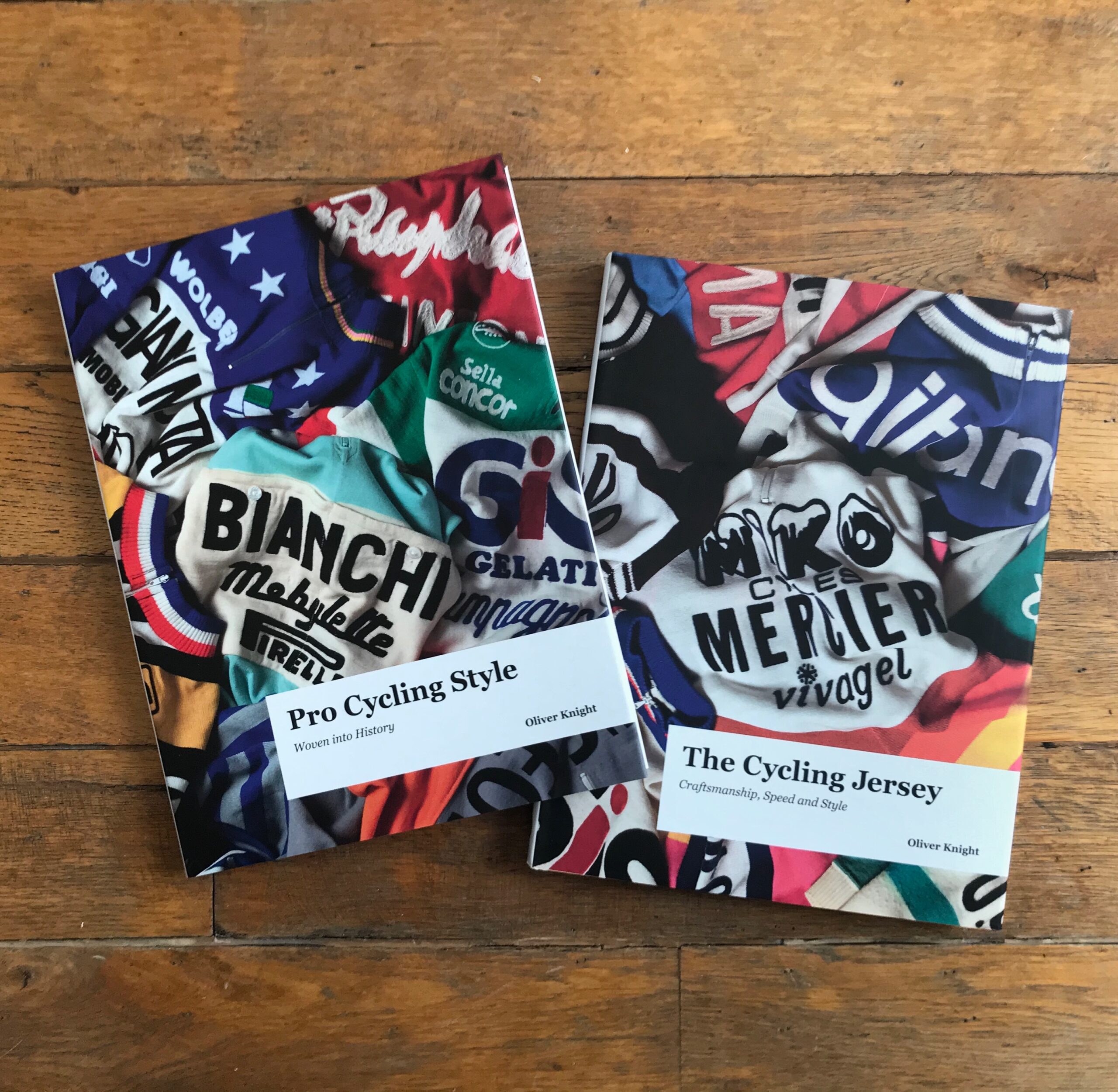Brooklyn Gios – the team that had it all
 What are the elements required to ensure a cycling team becomes mythic?
What are the elements required to ensure a cycling team becomes mythic?
Is it their race victories? The prowess and style of their riders perhaps? Or is it the design of their sponsors kit, or indeed the bikes they used to compete? As with other notable examples which have stood the test of time, the answer is undoubtably a combination of all these elements…
Sometimes, just rarely, these key elements find themselves in an equally abundant measure, creating a cycling team which leaves behind it a legacy held up as a shining example in the sport of cycling.
One team, above all others has earned this accolade – Brooklyn.
The allure of Americana
The enigmatic background story behind the creation of the Brooklyn team in 1973 can initially be traced back to post-war Italy, where thanks in part to the influence of American troops stationed in the country towards the end of the conflict, the country had developed a national obsession with all facets of American pop culture.
The brothers Ambrogio and Egidio Perfetti had launched their confectionary company Dolficio Lombardo near Milan in 1946, and by the mid 1950s had shrewdly spotted a huge gap in the Italian market; they decided to introduce Italians to that most American of habits – chewing gum. Their product ‘Brooklyn Chewing Gum‘, in both its name and iconography, rather unsubtly made the most of its American credentials and proved an instant success with the Italian market, proceeding to make them both very wealthy men.
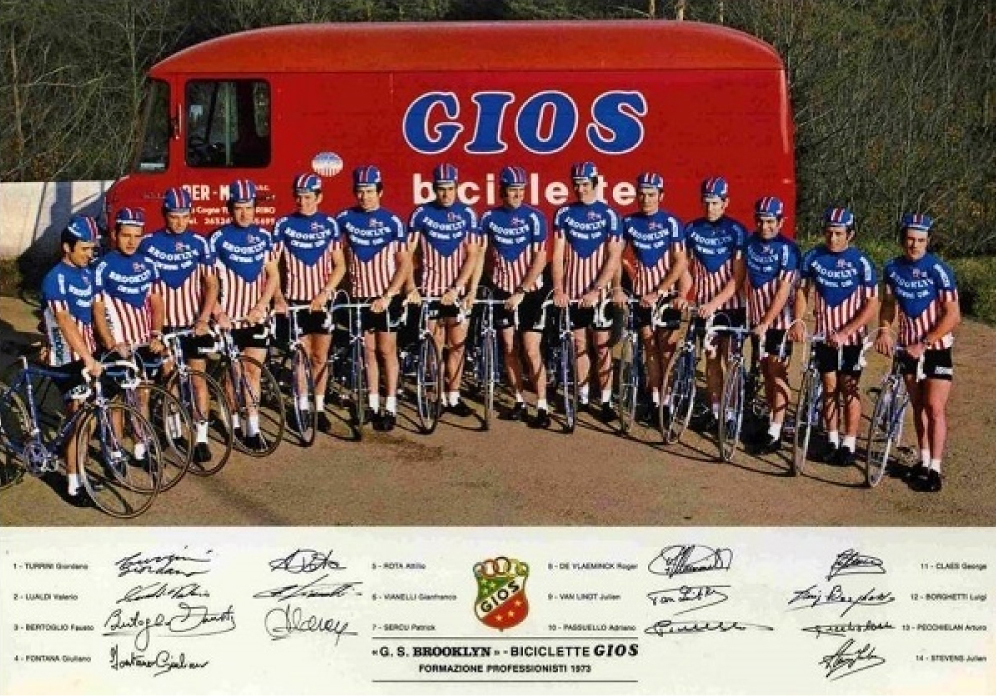
The legend is born, the Brooklyn cycling team in their livery of sponsor Stars and Stripes, with matching blue bicycles equipped by Gios of Turin.
Ambrogio Perfetti’s two sons, Augusto and Giorgio, would then join the company in the 1960s, and with the brand continuing to thrive they explored new ways to increase exposure of their gum product to the domestic Italian market. In 1971 the seeds of the Brooklyn sponsored cycling team were sewn when Giorgio Perfetti visited the Milan Trade Show, there striking up a relationship with the Turin based bike brand created by the Gios family.
At this time, the Gios catalogue of bike models consisted mainly of town and leisure bikes, and Giorgio was particularly struck by their ‘Easy Rider’ model which he declared would be perfect to give away as prizes for small amateur races they begun organising as part of their marketing campaign.

Brooklyn Chewing Gum advert from the mid 1970s, prizes include 100 ‘New York’ branded bicycles supplied by Gios
This was just the beginning of a key relationship for both companies, as when Brooklyn made the decision to take over title sponsorship of the Italian Dreher sponsored team for the 1973 season, it was Gios they chose as their bike supplier.
Gios would develop their mythic Super Record frame for the team riders, these painted in a matching colour at Perfetti’s request. A colour which would in turn go onto define the Gios brand (more on this later). While for the Brooklyn team kit only one combination of colours was ever going to be used, which both capitalised on the sponsors name, and created one of the most iconic jersey designs the sport has ever seen.
The Stars and Stripes enter the peloton
In taking over the Dreher team, Brooklyn had inherited an équipe of mighty cyclists. Managed by former pro Franco Cribiori, the team consisted of an equal split of both Italian and Belgian riders, all with impressive pedigrees.
The stars were undoubtably the Belgians Patrick Sercu; a supremely versatile rider specialising in six-day races, and the sensational one-day phenomenon Roger De Vlaeminck; whose victories prior to riding for Brooklyn included the Monuments Liège-Bastogne-Liège and Paris-Roubaix, as well as the accolade of the Points Classification in the previous years Giro d’Italia.
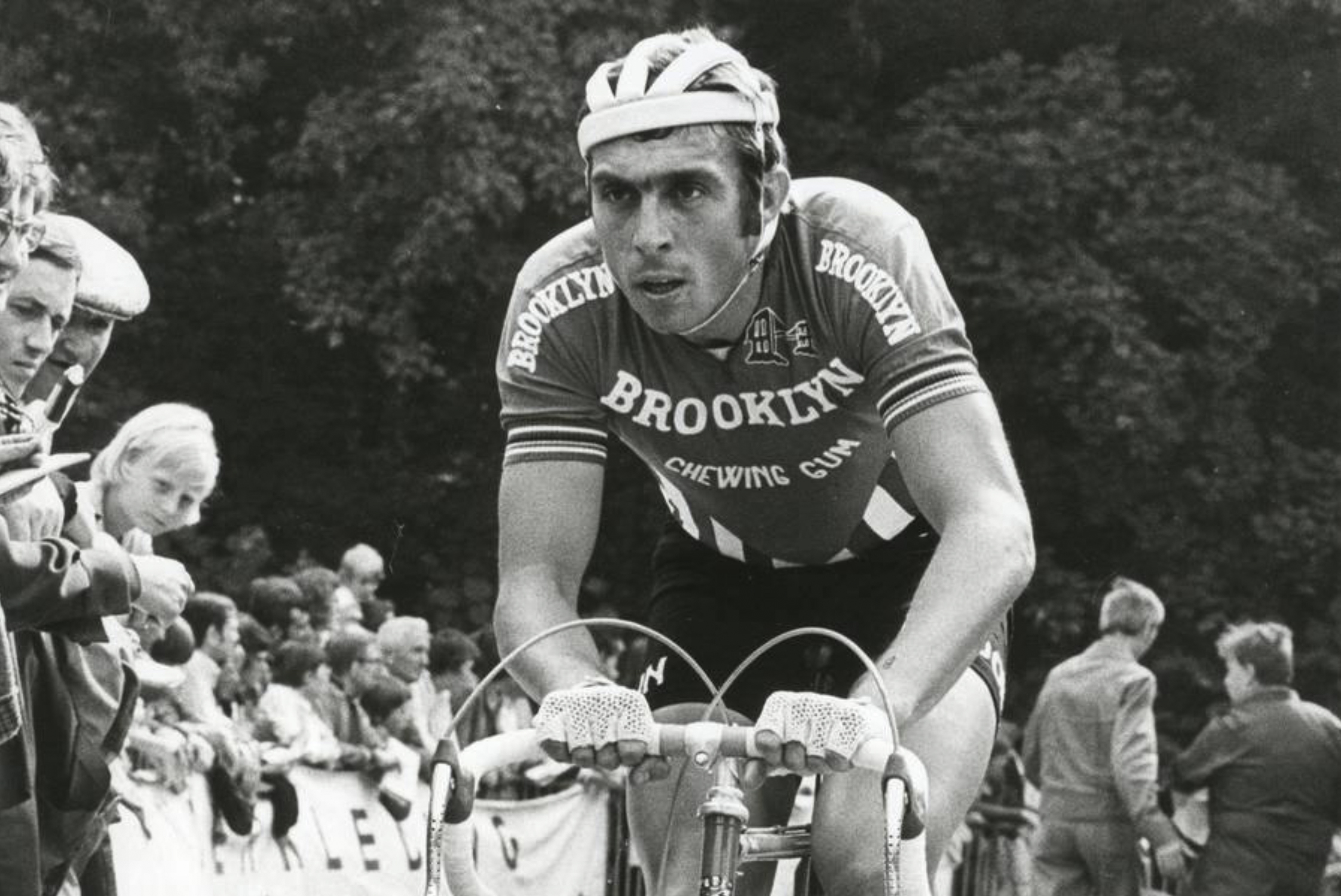
Patrick Sercu wearing the first incarnation of the Brooklyn Team jersey, a very short lived initial design.
De Vlaeminck was assisted by a roster of capable team-mates, including his brother Eric, the then six-time World cyclo-cross champion, and the future 1975 Giro d’Italia winner Fausto Bertoglio.
The team jersey commissioned by the Perfetti’s was unapologetically brazen in its design, broadcasting the company branding within a canvas that made full use of the iconic American Stars and Stripes. The initial design, seen above worn by Sercu was incredibly short lived, and only featured in pre-season promotional images aside from a few minor races.

Their first season would see no less than five alternates before their final (and most iconic design) would be settled upon. The teams second design seen above, from the collection of Gios aficionado Wayne Watkins, would now see the Brooklyn Bridge branding and chewing gum text jettisoned from the chest, whilst still remaining on the back. A change that would do little to increase the impact of the initial design.

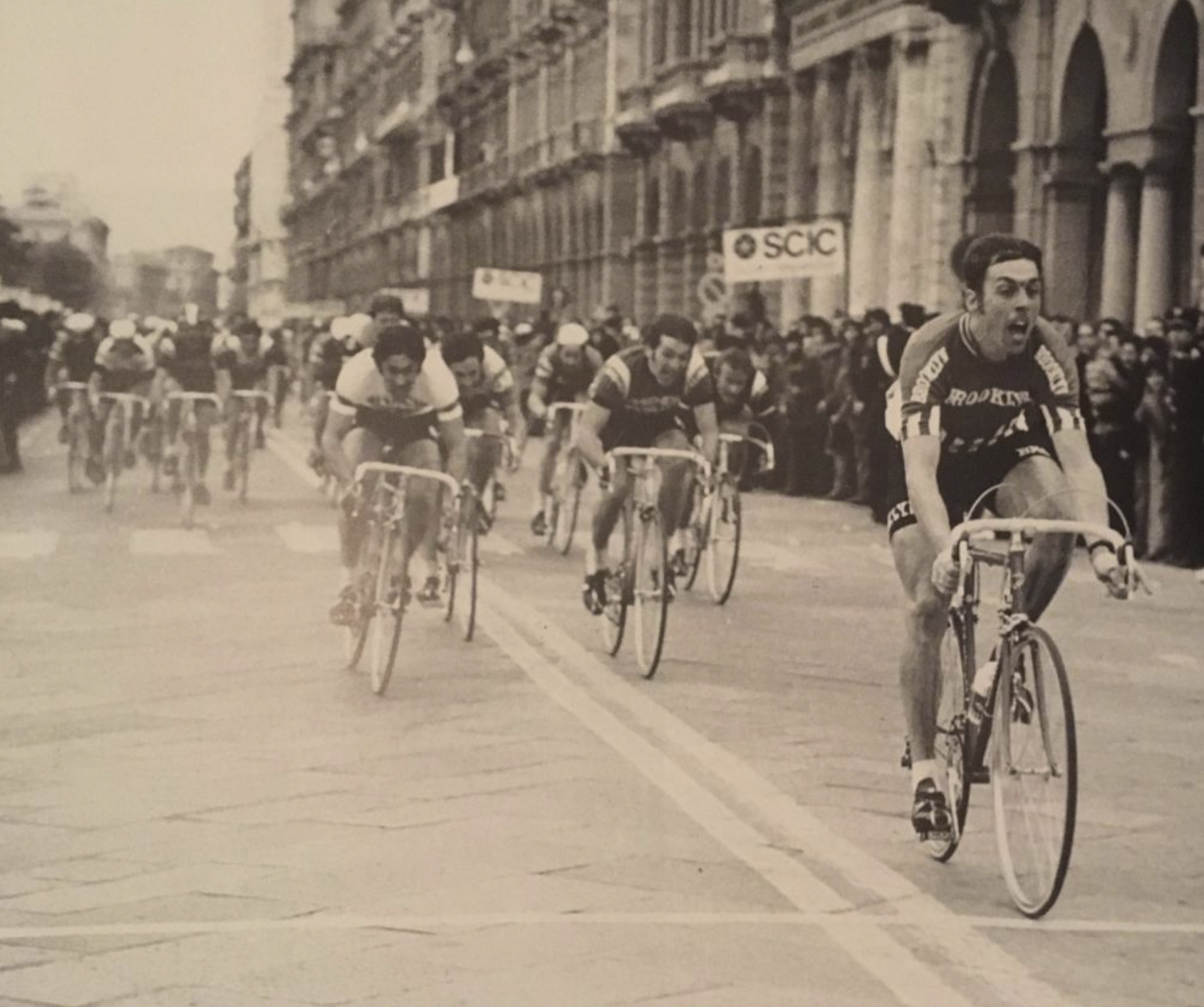
Patrick Sercu winning the Sassari-Cagliari race of March 2nd 1973, wearing the illusive second version of the Brooklyn team jersey.
This design would have its moments in the relative spotlight of the early season’s minor races, such as Sercu’s March 2nd win seen above, and Roger De Vlaeminck’s win of the GP Monaco a week earlier on the 21st February.
It would however be just a couple of weeks later, with the équipe now clothed in the third incarnation of the Brooklyn jersey, that their star rider would secure a major victory, heralding the start of the Brooklyn Gios legacy.

De Vlaeminck brings first major team win
Already counting two of the Monuments in his palmarès, the star Brooklyn rider De Vlaeminck was ambitious to add a third as he lined up at the start of the 1973 Milan-San Remo. His confidence no doubt boosted by the absence, due to illness, of the dominating five-time race winner Eddy Merckx.
In the final kilometres De Vlaeminck managed to escape, along with GBC’s Wilmo Francioni as they sped towards the finish. On the final straight the Belgian then pulled away, just as Italy’s Felice Gimondi, clad in the colours of the il Tricolore as the reigning National Champion threatened to catch the two leaders. But the determined De Vlaeminck held on, taking the finish line with a lead of just two seconds.

An iconic win not just for De Vlaeminck, but also for the Brooklyn team early in its maiden season. A point which clearly left its mark on the sporting press; ‘On the finish line of Via Roma, Roger De Vlaeminck’s jersey of stars and stripes was first to cross,’ wrote Gianni Pignata of La Stampa.
De Vlaeminck would cross the finish line in the third incarnation of the team jersey, one which now placed the bridge icon in a box at the chest. Again this would be a short lived design, as the seemingly jittery Perfetti family were still not entirely convinced the team jersey was getting across the Brooklyn brand message to the paying public as best it could.
In fact by the time their advertising publicising this Monument race victory was being created, this jersey design was already defunct.


Brooklyn advertisement showing De Vlaeminck’s victory, with some composite work now showing what Brooklyn would eventually settle on as the final branding at the chest. With this superimposed onto the original jersey he was wearing as he crossed the finish line it creates what must be the rarest of cycling jerseys – one that never actually existed!
Kit refinement
By the time the Brooklyn team had arrived in Verviers, Belgium for the May start of the 1973 Giro d’Italia, their team jersey had been refined to what would be its fifth and final design, one which would remain unchanged for the rest of the teams existence.

De Vlaeminck wearing the third incarnation of the Brooklyn team jersey, April 1973.
The rather fussy thin red lines on the body had been widened, with these also removed from the ends of the sleeves. The Brooklyn branding was now placed within an inverted chevron patch the chest, its black lettering against a white background drawing attention to the sponsor both simply and effectively. The iconic Brooklyn Bridge logo would still be present on the jersey, although now as a discreet chain stitched detail at the left breast.

Now clad in this iconic jersey design, the team performed admirably in the Giro, with Patrick Sercu and Roger De Vlaeminck taking a single and three stage wins respectively. Another notable victory from this first season would come from Patrick Sercu partnered with team mate Julien Stevens, winning the Six Days of Milan.
The following season of 1974, as the Belgian Johan de Muynck joined the équipe, would prove to be one of great successes for the team, in both the one-day Monuments and the Grand Tours. Roger De Vlaeminck would claim his second victory of Paris-Roubaix, and also take a fourth of the Monuments by winning the Giro di Lombardia.

The unmistakable silhouette of Roger De Vlaeminck, clad in the iconic Brooklyn jersey teamed up with the Gios Super Record.
As for the Grand Tour, De Vlaeminck would take an overall win of the Giro d’Italia’s Points Classification for a second time, while Patrick Sercu would also do the same in the Tour de France a few weeks later. The Brooklyn Team was now firmly on the map, with their riders accumulating an impressive list of race victories. All this while clad in a jersey which was almost impossible to tear your eyes away from, and furthermore equipped with a recently developed frame-set from Gios which was fast earning a fearsome reputation in top-flight cycling competition.

A fine example of the definitive Brooklyn jersey design, worn in the 1974 season by Johan de Muynck. From the collection of Wayne Watkins.

Detail of the manufacturers label from the Milanese tailoring firm Vittore Gianni.

Team kit bag featuring the ubiquitous Brooklyn branding.
The red, white and blue of the team colours, combined with the sponsor branding made for an extremely eye-catching identity. Whether transferred to casquette or support car, the Brooklyn branding commanded attention.
Add to this a team rider with the star quality of Roger De Vlaeminck, and it was clear that this jersey design would become a timeless classic. This fact not lost on the other riders in the peloton, as the former Pro Per Bausager recounts in his interview, Along with the cycling fans and sporting press, he too was just as spellbound in the presence of De Vlaeminck.

Roger De Vlaeminck flanked by two other Belgian racing legends; Freddy Maertens and Eddy Merckx, 1975. While the Brooklyn race jersey had been modified with wider red and white bands at the body by the Spring of 1973, the team training kit would keep the thiner lines. The original item seen below, another piece from Wayne Watkins extensive collection of Brooklyn Gios rider worn kit.

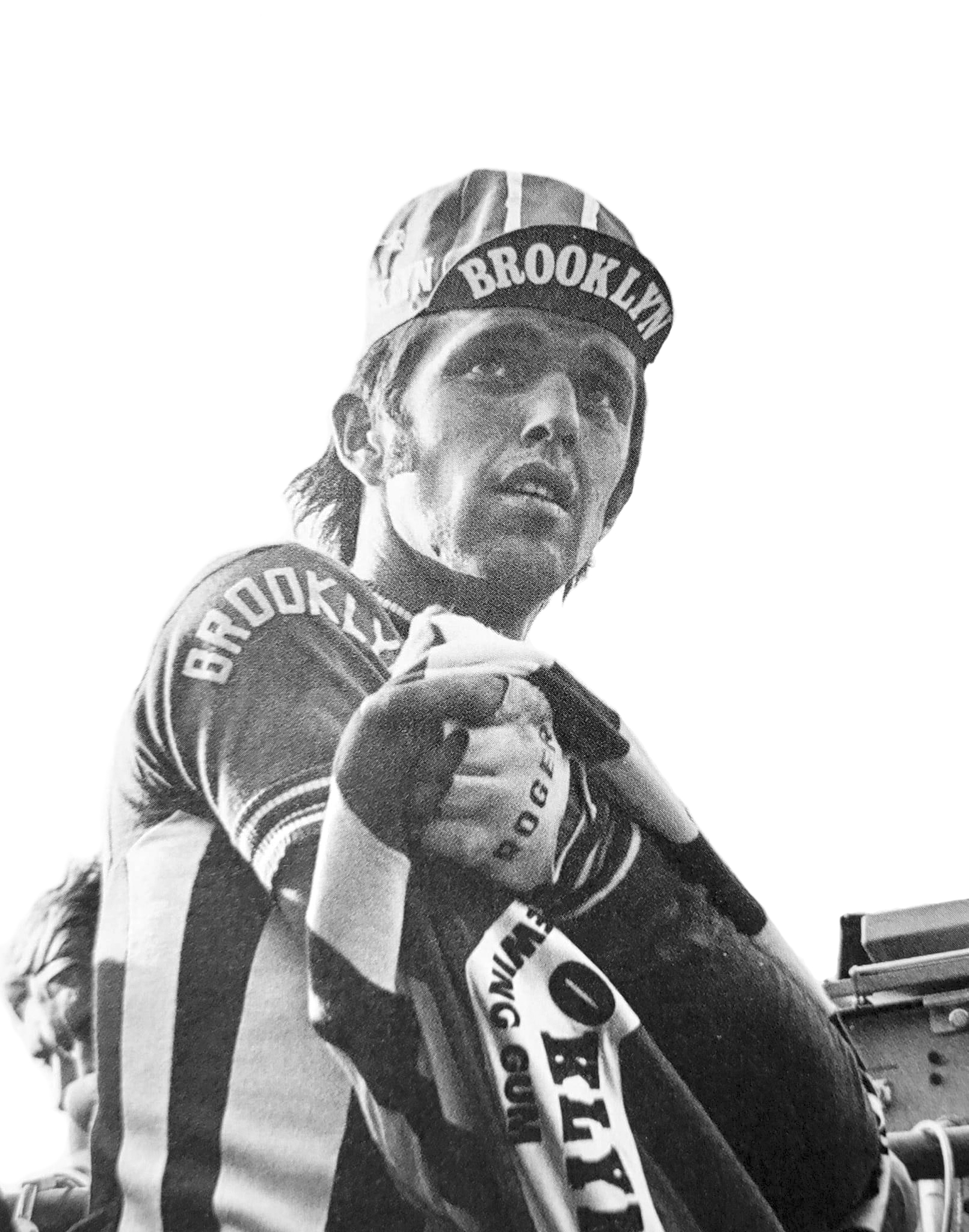
De Vlaeminck – equally photogenic both in and out of the saddle.
Brooklyn beyond the Stars and Stripes
Into the 1975 season and the Brooklyn branding would increasingly feature away from its standard setting, thanks to the victories of the team riders. Most iconically it would be teamed up with the World Champion rainbow colours after Eric de Vlaeminck had won the World Cyclo-cross title in 1973, and also in 1975 when Roger De Vlaeminck had stolen his brothers thunder at the World Cyclo-cross championships in Switzerland that January.

Roger De Vlaeminck as the reigning World Cyclo-cross Champion, with France’s Cyril Guimard in pursuit.
Later this season Brooklyn would once again be teamed up with the Giro’s maglia cyclamino, after De Vlaeminck secured the Points Classification for an incredible third time.
Patrick Sercu however would be unable to defend the same title at the 1975 Tour de France, due to an unfortunate event for their wealthy team sponsors. In January Egidio Perfetti had alarmingly been kidnapped from outside the gates of his villa, bundled into a car and then held ransom for a price of 2 billion lire (approx 10 million euro). An event whilst shocking, not entirely uncommon in 1970s Italy, as John Paul Getty III had famously found out in Rome just two years earlier.
With the ransom paid, and Egidio returned to his family (he got to keep his right ear, unlike the unfortunate Getty) it put a serious dent in the race budgets for the 1975 season, and while Brooklyn did compete at the Giro, the decision was made that their depleted budgets would not stretch to racing that years Tour de France as well.

Brooklyn in green, thanks to Patrick Sercu’s win of the Points Classification at the 1974 Tour de France.
Into the teams penultimate season of 1976, the Brooklyn Team then dominated the Tour de Romandie, with De Vlaeminck taking the Points Classification, Giancarlo Bellini the Mountains, and Johan De Muynck both the Combined and General Classification.
Indeed, this rise of De Muynck would signal the start of bitter in-fighting within the team, culminating with that years Giro d’Italia where De Vlaeminck had become enraged that De Muynck had profited from a crash which had in turn stripped him of the leaders Maglia Rosa. Despite the team manager Cribiori trying to unite the team behind the new race leader De Muynck, he essentially spent the rest of the race riding unsupported and alone, eventually loosing the General Classification in the final stage individual time-trial to Bianchi’s Felice Gimondi, by his overall lead of just 19 seconds.
If not for this unfortunate in-fighting, Brooklyn could have all too well claimed their first Grand Tour win. Johan De Muynck would however soon make up for this disappointed, by winning the Giro two years later riding with Bianchi.

Roger De Vlaeminck’s white Points Classification jersey from the 1976 Tour de Romandie, seen over the left shoulder of Patrick Den Hert – his stunning collection fully explored within the pages of our first book ‘The Cycling Jersey – Craftsmanship, Speed & Style’.

Giancarlo Bellini taking the Mountains Classification at the 1976 Tour de France.
Another notable accolade for the team in the 1976 season would come from Giancarlo Bellini. Having already taken the Mountain Classification in the Tour de Romandie, he then went on to do the same at the Tour de France, entering into the history books the Brooklyn branding teamed up with the Tour de France’s iconic polka dot jersey.

Roger De Vlaeminck in an alternate Brooklyn six-day jersey design, featuring white sleeves.
Another opportunity for variations on the standard Brooklyn jersey design was also afforded by the six-day races, where subtle variations, as seen in these two examples from De Vlaeminck and Mantovani, would give further weight to this most iconic of jersey designs.
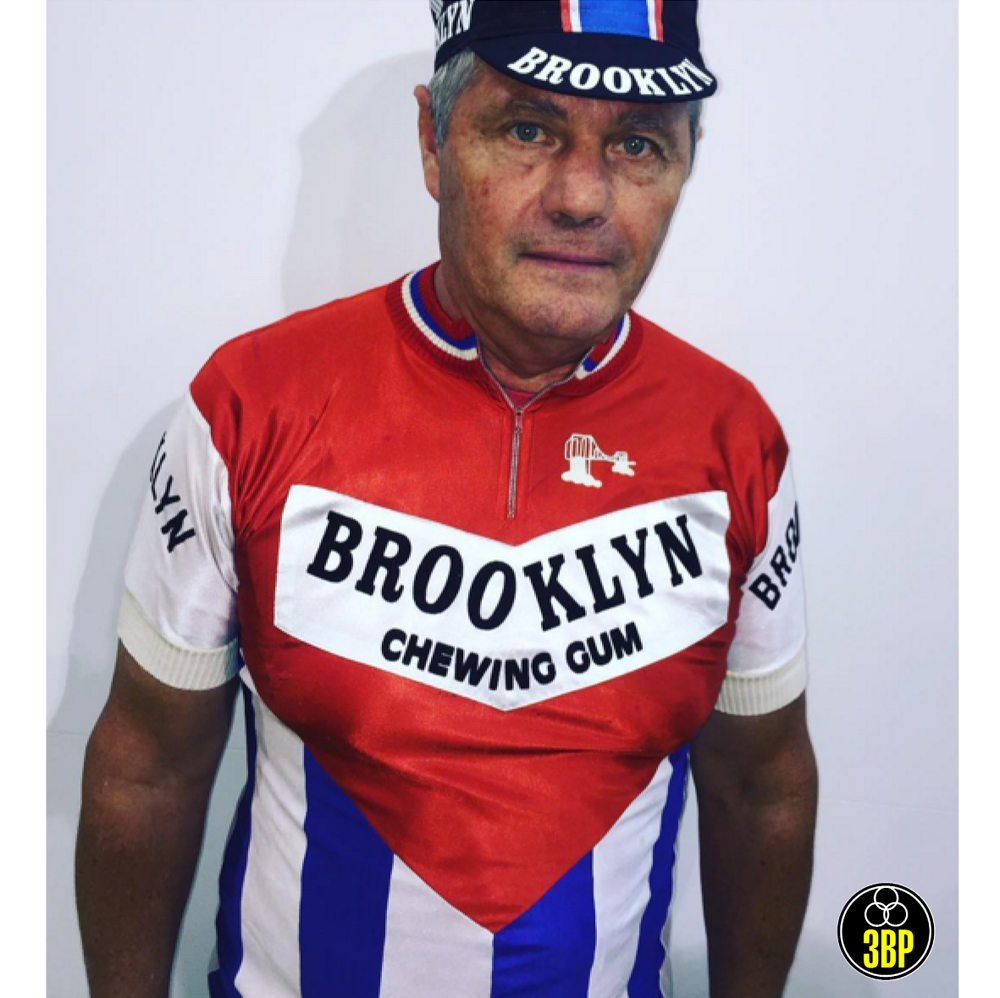
A most stunning alternate design on another six-day jersey, featuring reversed colours. Worn by Giovanni Mantovani in his first and only year with the team at the 1977 six-days of Milan.
The final year; all five Monuments and a fourth Paris-Roubaix
The final year of the Brooklyn team of 1977 would have been a quiet one, if not for the exploits of Roger De Vlaeminck, who would write himself into the history books.
In early April he had won the Tour of Flanders, giving him victories of all five of the Monument Classics, a feat only equalled by two other riders, the fellow Belgians Rik Van Looy and Eddy Merckx.
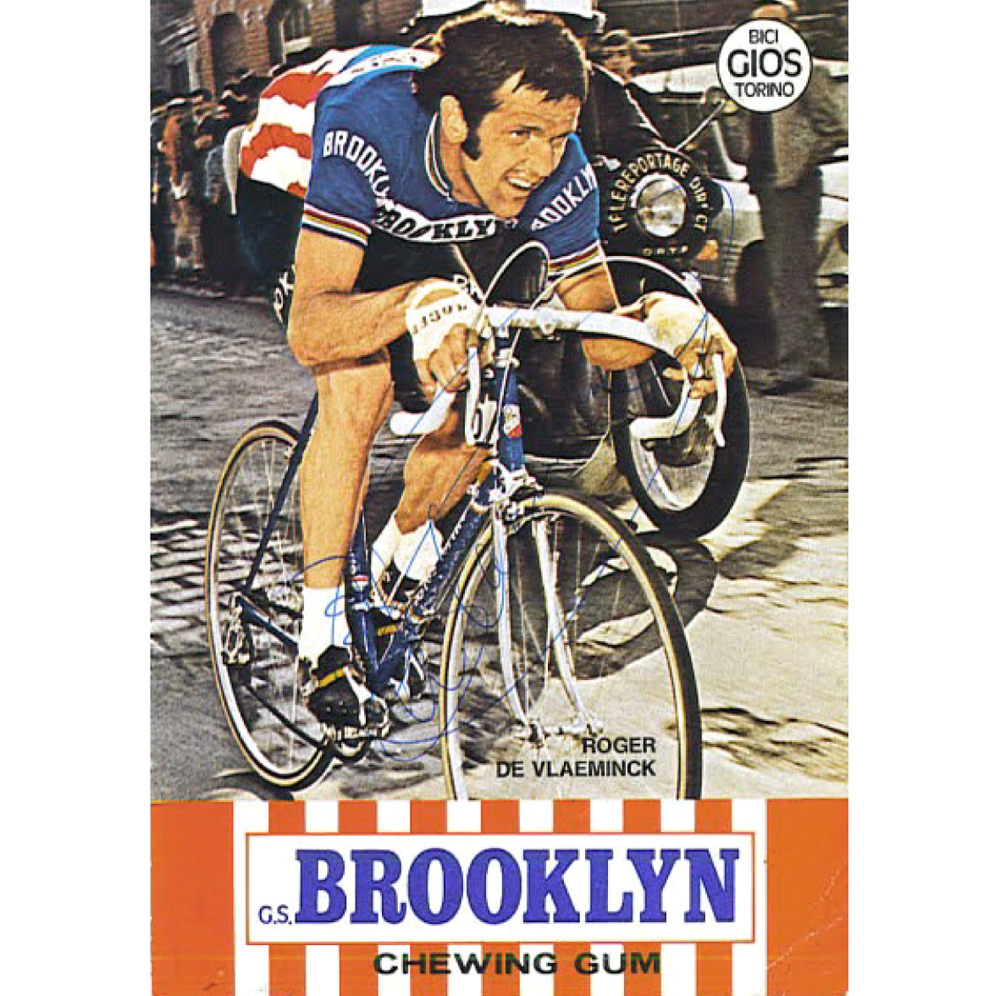
‘Mister Paris-Roubaix’ in his element.
With his sights now set on the upcoming Paris-Roubaix two weeks later he prepared himself for what would be a historic fourth win of the gruelling race, a feat then unequalled in the history of the sport.
The previous year he had narrowly missed out on this record breaking feat, as famously documented in the excellent film ‘A Sunday in Hell’ by miscalculating a sprint finish in the Roubaix Velodrome along with Francesco Moser and Marc De Meyer, who had taken the finish line.
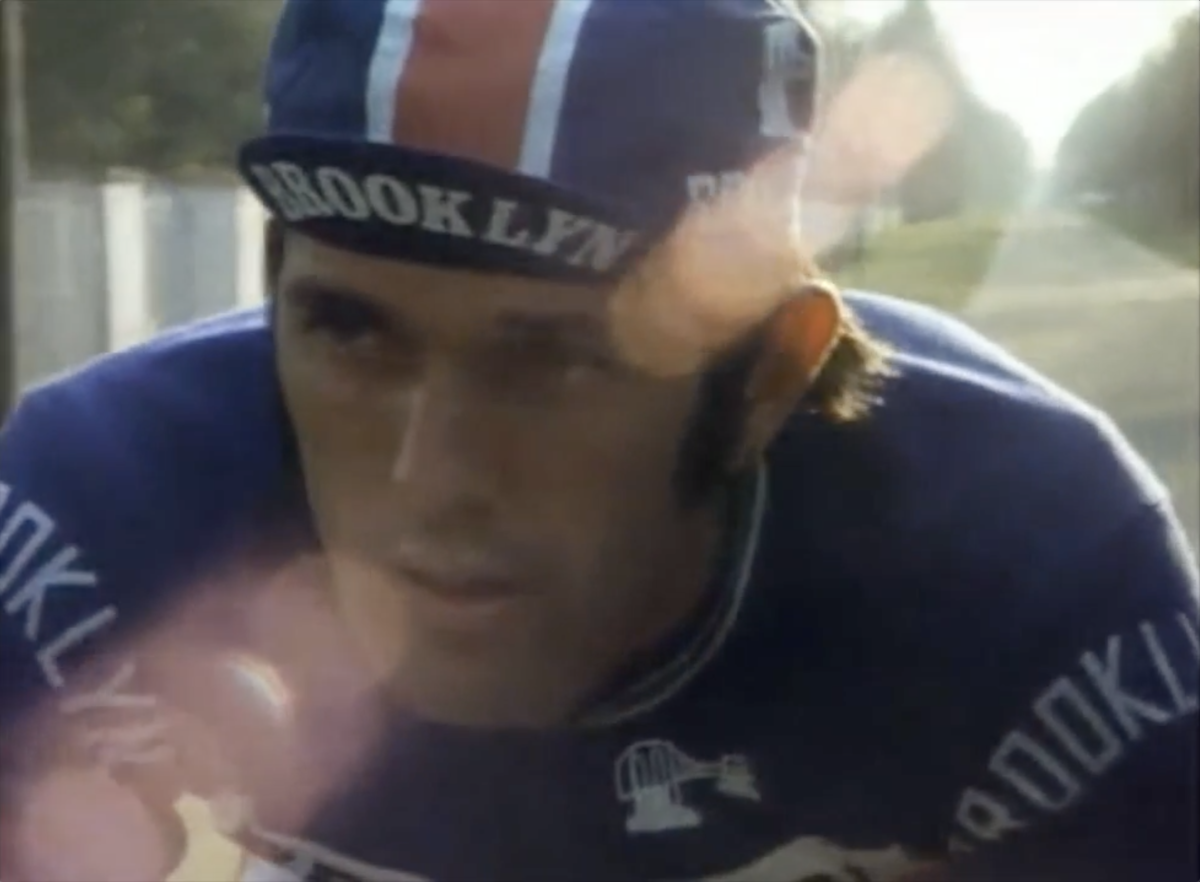
For the race of 1977 he managed to break away from the race leaders in the final kilometres, building a lead over them of over a minute. He entered the velodrome alone and unchallenged, waving to the crowds in what would be a victory lap in taking a historic fourth victory of Paris-Roubaix. A feat that would remain unequalled for 35 years, until fellow Belgian Tom Boonen would also complete a fourth win of the race in 2012.
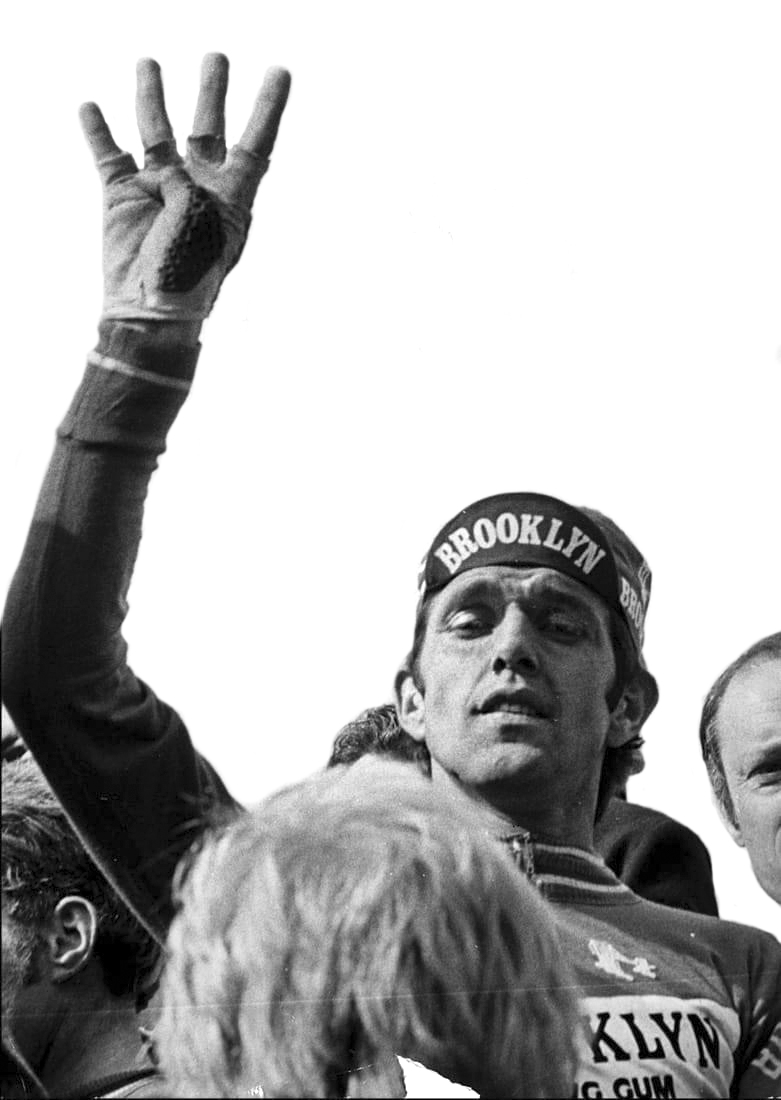

The Gios Torino Super Record
The other undoubted star of the Brooklyn team were the frame-sets that were developed and produced for them by the Gios brothers Alfredo and Aldo along with their team of master frame builders.
Prior to focusing on professional racing frames the company, founded by their father the respected former pro Tolmino, had mainly produced functional town and leisure bikes, these including the fabled ‘Easy Rider’ which had first drawn Giorgio Perfetti to the Gios brand at their fateful meeting in Milan in 1971.

Through the expertise of Gios, paired with the prodigious talents of the Brooklyn team riders, their newly developed steel Super Record frame-sets were ridden to numerous historic victories by the likes of De Vlaeminck and Sercu, leading to them so soon after their launch quickly becoming one of the most decorated and widely admired racing bicycles.
Produced for the Brooklyn team in a matching shade of electric blue, this colour has gone onto define the company, and is still being proudly used by them today. In the words of Alfredo Gios himself; “Like Henry Ford, I will sell you a bike in any colour you like… As long as it’s blue.”

Roger De Vlaeminck’s Gios Torino Super Record, ridden to victory in his third Paris-Roubaix title of 1975. Pride of collection for Wayne Watkins, and personally restored by Aldo Gios.

More items from the Gios legacy housed in Wayne Watkins stunning collection. Top a Gios Pista, one of only 51 made for the Brooklyn Team riders. Bottom left a 1972/1973 team bike issued to the amateur Fiat team of Turin. Bottom right is one of the first Brooklyn team bikes made by Aldo with his team of frame builders, featuring the very first Gt front fork and bottom bracket.
Beyond Brooklyn
Will the dissolution of the Brooklyn team at the end of the 1977 season, Gios continued to supply their lauded frame-sets to the worlds best professional cyclists.
In 1977 they had already taken the decision to be the title sponsor of a Cyclo-cross team built around Eric De Vlaeminck, and in 1978 they then signed a deal with the Belgian confectionery brand Ijsboerke to equip their team of riders. With Ijsboerke they would once again would see their Super Record claim another Monument, thanks to Didi Thurau’s victory of the 1979 Liège–Bastogne–Liège.

Roger De Vlaeminck reunited with Gios towards the end of his career when spending the 1983 season with the Gios-Clement sponsored team.
With their bicycles impeccable reputation, Gios continued to supply many teams in the peloton. Into the 1980s and Fons de Wolf would ride his Gios to victory in the 1981 Milan-San Remo, be ridden by a host of Italian stars within the 1989 Jolly Componibili team, and become a firm favourite with the Irish legend Stephen Roche.

Elegant and understated 1977 Gios Torino jersey, for their headline sponsorship of the Cyclo-cross team built around Eric De Vlaeminck.
After Brooklyn’s departure from sponsoring a professional cycling team, their iconic branding would still appear from time to time within the world of sport. In 1979 they would be a sponsor of the South African Formula 1 driver Jody Sheckter, when he won the Drivers Championship with Ferrari.

The Brooklyn branding now seen linked with four wheels rather than two, on the race suit of Jody Sheckter in 1979.
Brooklyn were however still not quite finished with the world of cycling, their famous jersey design making a brief comeback for their sponsorship of leaders jersey of the Giro Delle Regioni in the mid 1980s. This regional Italian tour open to aspiring professionals, acting as a launch pad into the pro peloton for past for winners including Ivan Basso and Maurizio Fondriest.
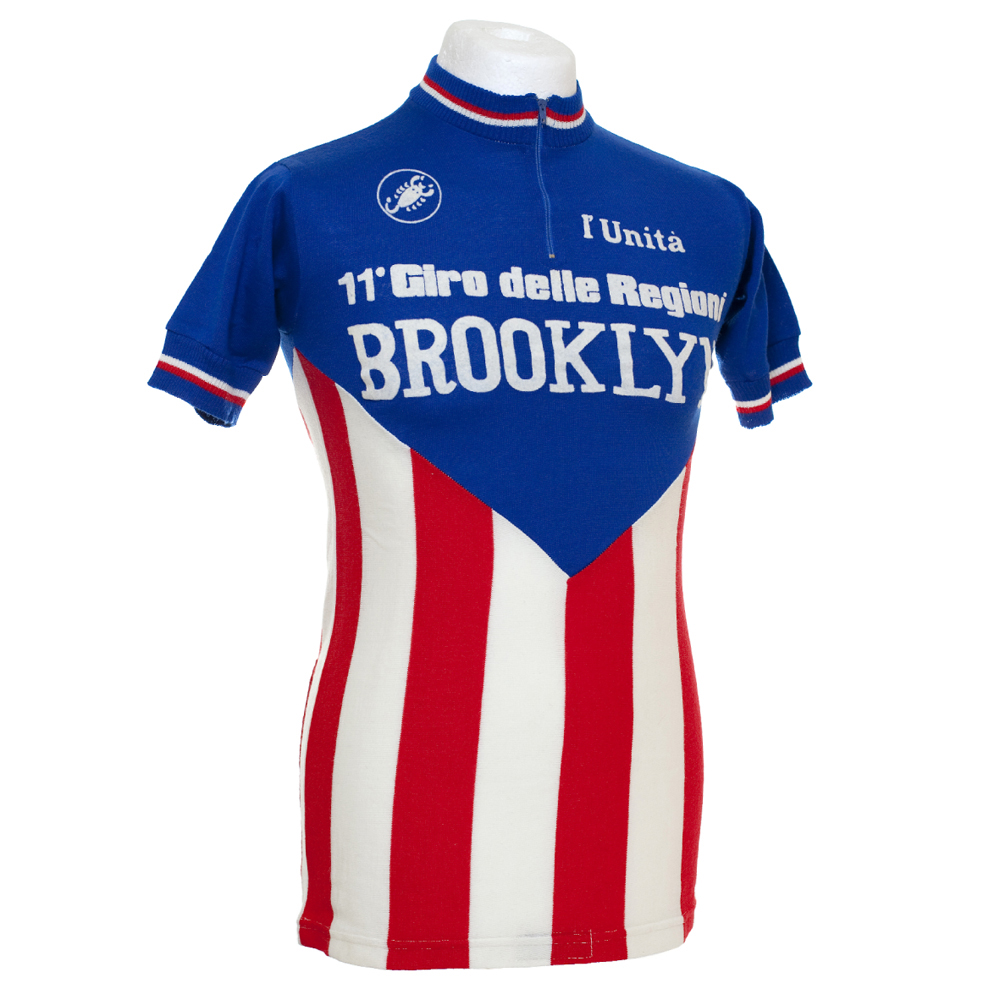
A devoted following
The legacy of both the Brooklyn team and the Gios bikes with which they were equipped has created an almost cult following. With devotees far and wide their legacy continues to inspire. In one such case, that of the American Michael Gamstetter, his love for both Brooklyn and Gios inspired him to emulate De Vlaeminck and make the pilgrimage to participate in the Paris-Roubaix challenge, a race open to amateur riders which followed the route of this most famous of all the one-day Monuments.

Gamstetter completing the Paris-Roubaix challenge, in a complete livery of both Brooklyn team kit and bike.
With his meticulous eye for detail, Michael made sure he was not just completing the event on a period correct 1973 Brooklyn issue Super Record (this particular one formerly used by team rider Julien Stevens) but also with a complete wardrobe of the correct rider kit too. The fact that original 1973 Brooklyn kit is difficult, if not impossible to come by did not deter him, and he proceeded to have these pieces custom made for him by the likes of Tiralento, 2Velo and Magliamo, who specialise in creating incredibly faithful reproductions.

Michael’s wardrobe of faithfully reproduced Brooklyn kit, painstakingly researched and sourced from a number of manufacturers.

The full story of Michael’s pilgrimage can be discovered within our book ‘Pro Cycling Style’, available here at our online store
Michael’s own personal story acts as a wonderful testament to the devotion this team, its riders, and its bikes has inspired in many people across the globe, with your author very much counting himself among them.

1973 Brooklyn team Gios Super Record, used by Julien Stevens. Faithfully restored in every last detail and riding the Roubaix cobbles once again over 40 years later, thanks to its devoted custodian Michael Gamstetter.
The wider reach and influence of Brooklyn
The iconic and attention grabbing Brooklyn branding would live on, and in the late 1980s achieve another cult status far outside its native Italy. In the city from which the brand took its name, the film director Spike Lee would don the teams cycling cap in his 1986 film ‘She’s Gotta Have It’, playing the character of Mars Blackmon, a Brooklyn loving (the borough, not the team) fan of the New York Knicks and Nike Air Jordan.

The complete investigation of popular cultures appropriation of cycling within our book ‘Pro Cycling Style’, available here at our online store
The sportswear brand were paying attention, and swiftly approached Lee to appear in a huge campaign of publicity for the Air Jordan sneaker model. The series of Press and broadcast ads featuring Michael Jordan, the coveted sneakers, accompanied by Lee in the role of Mars wearing of course, the iconic Brooklyn cycling cap.
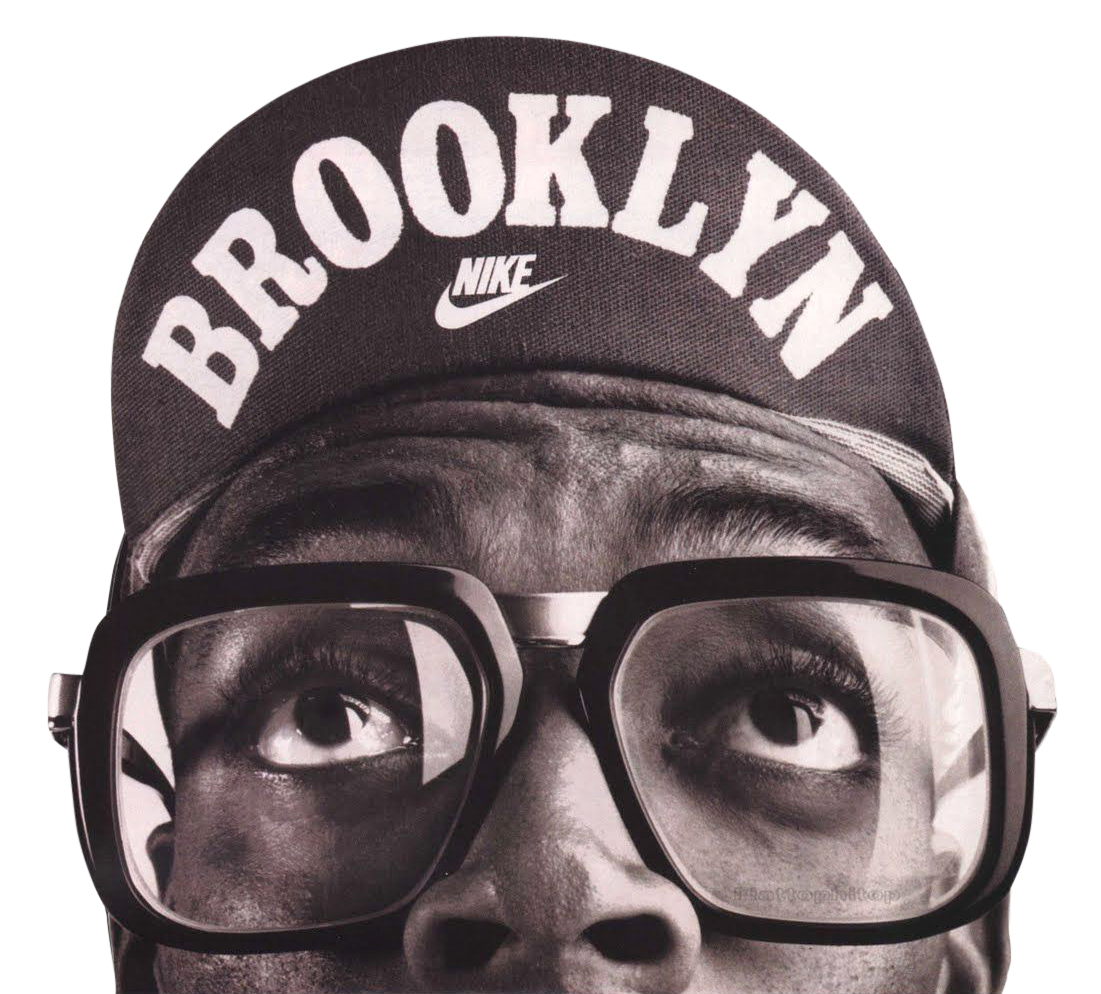
In turn, it only seemed right that when I visited the city back in 2017, whilst completing a series of worldwide book launch events for our first book ‘The Cycling Jersey’, which culminated with a launch supported by the fantastic team at Rapha NYC in Soho, I should honour the place which gave birth to the chewing gum brand and the mythic cycling team!

The bridge and borough which gave birth to the Brooklyn team legacy.
And the success of the Stars and Stripes used in jersey design would also live again, as recounted by our New York book launch guest John Eustice. And fittingly, this time they would be used to announce the presence of the first professional American team to compete in the Giro d’Italia. The beginning of another great legacy, as the Americans tentatively entered the world of European professional cycling…

Former pro John Eustice, captain of the 1984 Gianni Motta cycling team. A team who like Brooklyn, and with good reason, also capitalised on using the iconic Stars and Stripes for their jersey design. Speaking at our launch event hosted by Rapha NYC for our first book ‘The Cycling Jersey – Craftsmanship, Speed & Style.
More on the rich legacy of Gios can be seen via the following links:
Their hand-built, Italian made mythic frame-sets: giostorino.it
A catalogue of their beautifully restored rider issued bicycles: instagram.com/r_s_giostorino
Their range of modern racing bicycles: gios.it

I do hope you’ve enjoyed this post – many more gorgeous race worn items, and tales from the peloton can be discovered within both our 200 page coffee-table books ‘The Cycling Jersey – Craftsmanship, Speed and Style‘ and its new follow-up title ‘Pro Cycling Style – Woven into History’

Share This Story, Choose Your Platform!
 What are the elements required to ensure a cycling team becomes mythic?
What are the elements required to ensure a cycling team becomes mythic?


















































